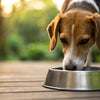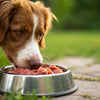How Much Should My Dog Eat Raw Food? A Comprehensive Guide for Pet Owners
- Houndsy
Table of Contents
- Introduction
- Understanding Raw Feeding for Dogs
- How Much Raw Food Should I Feed My Dog?
- Transitioning to Raw Food
- FAQs About Feeding Raw Food to Dogs
- Conclusion
Introduction
Picture this: you’re watching your beloved dog happily wagging its tail, eager for mealtime. As pet owners, we all want to ensure our furry friends are not only satisfied but also healthy and thriving. In recent years, more dog owners have made the transition from traditional kibble to raw food diets, fueled by claims of improved health benefits such as shinier coats, cleaner teeth, and more energy. However, amidst the excitement of trying something new, a crucial question arises: how much should my dog eat raw food?
Understanding the proper portion sizes for a raw food diet can be a bit perplexing. With varying factors including your dog’s size, breed, age, and activity levels, determining the right balance is essential for optimal health. In this blog post, we will explore key considerations for feeding raw food, delving deep into portion guidelines, the benefits of a raw diet, and tips to ensure your pup receives balanced nutrition.
By the end of this article, we will provide you with a comprehensive understanding of how much raw food your dog should be eating, tailored to their specific needs. Join us as we delve into this discussion, invite reflection on your current feeding routines, and inspire you to discover a mindful approach to your dog’s nutrition.
Understanding Raw Feeding for Dogs
What is Raw Feeding?
Raw feeding is a style of nutrition that mimics the ancestral diet of dogs, consisting primarily of uncooked meats, bones, fruits, and vegetables. Often referred to as the BARF (Biologically Appropriate Raw Food) diet, the philosophy hinges on the belief that these natural, unprocessed foods are more beneficial for canine health compared to commercial kibble, which can be laden with fillers and artificial additives.
Components of a Raw Diet
To build a balanced raw food diet, many pet owners follow the 80/10/10 rule which suggests that approximately:
- 80% muscle meat (such as chicken, beef, and turkey)
- 10% raw edible bones (like chicken necks or wings)
- 10% organ meat (including liver, kidneys, and hearts)
Additionally, a small portion of fruits and vegetables can be included (about 5-10%), alongside necessary supplements to enhance nutrition. Understanding these components can help you create a well-rounded meal plan for your dog.
Benefits of Raw Feeding
There are many noteworthy benefits that dog owners associate with transitioning to a raw diet, including:
- Leaner, more muscular build: Raw diets often contribute to lower body fat levels and improved muscle tone.
- Healthier skin and coat: A diet rich in natural oils and nutrients contributes to a shinier, healthier appearance.
- Better dental health: Chewing raw bones can help reduce plaque buildup and improve dental hygiene.
- Increased energy levels: Many owners report that their dogs become more active and enthusiastic after switching to raw food.
- Smaller stools: Raw diets typically lead to less waste due to higher digestibility and lower filler content.
The positive effects mentioned have a collective impact on your dog's overall well-being, making raw feeding an attractive option for many.
How Much Raw Food Should I Feed My Dog?
When it comes to determining how much raw food your dog should consume, several factors come into play. These include their weight, age, activity level, and overall health. Below is a guide to help you navigate this aspect of raw feeding.
General Feeding Guidelines
Adult Dogs
For adult dogs, a good rule of thumb is to feed between 2-3% of their body weight per day. Here's how it breaks down based on activity levels:
- Less Active Dogs: Aim for closer to 2% to maintain a healthy weight.
- More Active Dogs: Feed on the higher end, about 3%, to meet their energy and nutrient demands.
For example, if you have a 50 lb. (22.7 kg) active dog:
[ 22.7 \text{ kg} \times 0.03 = 0.681 \text{ kg} \text{ (or 681 grams) of raw food daily} ]
Puppies
Puppies have different dietary needs due to their growth stages. As they grow, the percentage of food requires adjustment:
- 2-3 Months Old: 8-10% of current body weight.
- 4-6 Months Old: 6-8% of current body weight.
- 7-12 Months Old: 4-6% of current body weight.
For instance, if you have a 4-month-old puppy weighing 10 lbs. (4.5 kg):
[ 4.5 \text{ kg} \times 0.07 = 0.315 \text{ kg} \text{ (or 315 grams)} \text{ of raw food daily} ]
Senior Dogs
Senior dogs may require less food based on their activity levels or health conditions. Generally, feeding at around 2% of their body weight is a good starting point. For example, a senior dog weighing 60 lbs. (27.2 kg) would need:
[ 27.2 \text{ kg} \times 0.02 = 0.544 \text{ kg} \text{ (or 544 grams) of raw food daily} ]
Adjusting Portions Based on Other Factors
It's important to remember that the above guidelines are starting points, and adjustments may be necessary based on your dog's unique needs. Factors to consider include:
- Activity Level: If your dog is more athletic, they may require higher food quantities. Conversely, less active dogs may need less.
- Temperament: An excitable dog may need more energy, leading owners to adjust food portions accordingly.
- Health Conditions: Dogs with specific health issues or those who are overweight may also require specialized feeding plans. Always consult with your veterinarian for tailored recommendations.
Transitioning to Raw Food
Making the switch from kibble to raw food can come with its own set of challenges. Here are some essential tips to help effectively transition your dog to a raw diet:
Start Gradually
When introducing raw food, start by mixing small amounts of raw food with their current diet. Over a period of several days (ideally 7-10 days), gradually increase the raw food while decreasing the kibble. This helps minimize digestive upset and allows your dog to adapt.
Observe Your Dog’s Reaction
As you transition, keep an eye on your dog’s digestion and energy levels. Any signs of discomfort, loose stools, or decreased appetite may necessitate a slower transition or adjustments in the food.
Ensure a Balanced Diet
To maintain nutritional balance, it's vital to offer a variety of meats, bones, and organs in the right proportions. Working with a nutritionist or utilizing pre-made raw food options can help ensure completeness and balance.
Maintain Cleanliness
Raw food preparation can pose risks of bacterial contamination if not handled properly. Always wash your hands, utensils, and surfaces thoroughly after preparing or serving raw food to keep your family safe.
FAQs About Feeding Raw Food to Dogs
What are the potential risks of raw feeding?
While many dogs thrive on a raw diet, there are inherent risks that pet owners should be aware of. Bacteria such as Salmonella and E. coli can be present in raw meat. Practicing high hygiene standards during preparation can mitigate these risks. Always consult your veterinarian before transitioning your dog to a raw diet, particularly if they have health issues.
Can I mix raw food with kibble?
Most experts recommend against mixing raw and dry food in one meal, as they digest differently. It is typically better to separate these meals to avoid digestive upset.
How do I store raw food?
Raw meat should be stored in the freezer until needed. Once thawed, it can be kept in the refrigerator for a few days. Ensure that all meals are served fresh and that any uneaten food is discarded to avoid spoilage.
Is it safe to feed bones?
Feeding raw, meaty bones is beneficial as they provide needed calcium and are less likely to splinter compared to cooked bones. However, avoid small or brittle bones that can pose choking hazards or cause injury.
Should I consult my vet before switching to a raw diet?
Absolutely. Consulting with your veterinarian ensures that your dog's nutritional needs are met, particularly if they have pre-existing health conditions or are on medication.
Conclusion
Switching your dog to a raw food diet can be a wonderful journey toward better canine health and vitality. Carrying an understanding of how much your dog should eat raw food is vital for balancing their nutrition effectively. By considering factors such as weight, age, activity level, and potential health issues, you can ensure your furry friend thrives.
As you embark on this feeding adventure, don’t hesitate to reach out to a veterinarian for further guidance, especially during the transition. While maintaining a clean and organized feeding routine, you can create a nourishing environment that enhances your dog’s quality of life—one meal at a time.
Ready to simplify and elevate your dog’s feeding experience? Consider incorporating the Houndsy Kibble Dispenser for an innovative way to manage your dog’s meals seamlessly. Explore the Houndsy Kibble Dispenser today and discover the convenience, quality, and design that fit your lifestyle and your pet’s needs beautifully.












